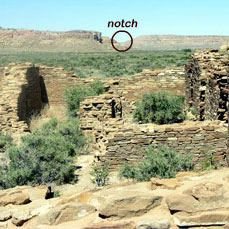
|
||||||
|
|
||||||
|
|
|
|
|
|
|
|
|
|
||||||
Wijiji Wijiji is one of Chaco’s great houses , and may also have served to anticipate and confirm the date of the winter solstice . Standing at the northwest corner of Wijiji, you can see the sun rise at the northern edge of a distant notch in the horizon, sixteen or seventeen days before the winter solstice. Over the course of the next sixteen or seventeen days, the sun seems to traverse the notch. Finally, on the morning of winter solstice, you can see the sun rise at the southern edge of the notch.
Being able to anticipate the arrival of winter solstices would have been crucial to the ancient Pueblo, to allow time to prepare for ceremonies marking the occasion. These ceremonies were of the utmost importance; if they were not performed correctly, the sun might continue on its southward journey and never return, bringing perpetual cold and darkness.
|
||||||
 Nearby,
another site designated by the park service as "Wijiji 931,"
affords a similar opportunity to anticipate and confirm the summer solstice.
This spot, marked by a
Nearby,
another site designated by the park service as "Wijiji 931,"
affords a similar opportunity to anticipate and confirm the summer solstice.
This spot, marked by a
